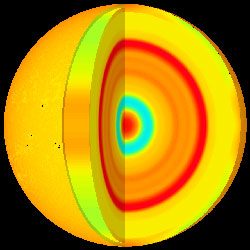Proton Pulse Gives Plasma Possibilities

It lurks in the dense interior of Jupiter and boils deep within the sun. Warm dense plasma, so common in the universe, is very difficult to manufacture on Earth’s surface. In the 19 September PRL, a team describes their method of zapping aluminum foil with a proton beam to create a blob of warm dense plasma–a form of matter very different from other types of plasma. The technique may allow for previously impossible measurements that could lead to more accurate models of star and planetary interiors.
A plasma is a gas of electrons and positively-charged ions, but it’s usually tenuous stuff, as in a candle flame, an interstellar gas cloud, or inside a fusion reactor. Warm, dense plasma–which may predominate in some layers of the sun, the cores of large planets, and perhaps the earth–is denser than water and far denser than other types of plasma. Despite the name “warm,” it can be as hot as the more common types. According to Pravesh Patel of the Lawrence Livermore National Laboratory in California, warm dense plasma is a mysterious phase of matter. It may have complex behaviors, but without an appreciable quantity to measure, no one knows what these behaviors may be. The few theoretical models differ wildly.
Researchers have made warm dense plasma in the past by using ultra-short laser pulses to directly heat a solid surface. But with this technique, the temperature varies dramatically over the plasma region, and probe lasers can’t penetrate more than a few tens of nanometers. Particle beams can heat an object more quickly and uniformly than lasers, but even the biggest ion accelerators can’t get material to plasma temperatures quickly enough–the sample explodes before the warm, dense state can be probed.
Patel and his colleagues heated a sample with far more protons than an accelerator could provide, using a technique developed at Livermore in recent years for other purposes. A short, intense laser pulse blasts a thin aluminum foil target, which releases a mob of high-energy protons from its back surface. The protons hit the next target–another thin piece of aluminum–and dump massive amounts of energy within picoseconds. The second target heats to tens of thousands of degrees but remains temporarily dense. Then, for a few nanoseconds before it explodes, when the aluminum is in a warm dense state, the team can measure the plasma’s light absorption and optical emissions, which reveal the temperature and other properties. The researchers also plan to measure the speed of the explosion’s shock wave to get further data.
According to Roger Falcone of the University of California at Berkeley, the technique has good potential for heating solid matter for plasma studies, but whether it’s truly better than other techniques depends on the uniformity of the plasma produced. Steven Rose of the Atomic Weapons Establishment in Aldermaston, UK, says the technique can create conditions “ideal for performing material properties experiments.” He adds that with a better laser, the technique could heat material to much higher temperatures than is currently possible, suggesting that even hotter dense plasma could be produced in the future.
–Kim Krieger
Kim Krieger is a freelance science writer in Norwalk, Connecticut.


